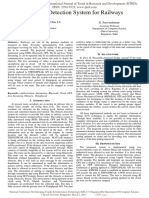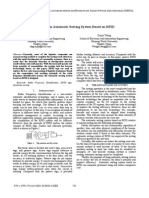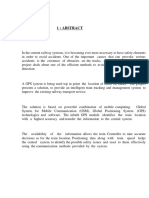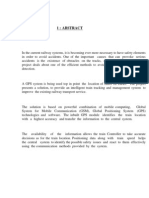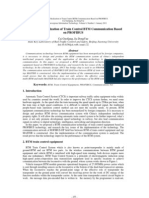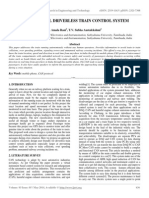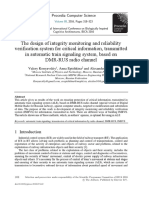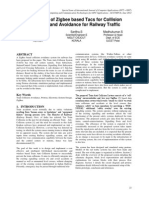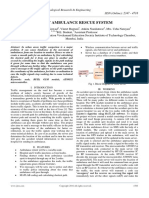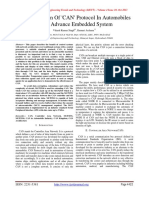Professional Documents
Culture Documents
Real Time Train Tracking System With On-Board Colour Light Signals.
Uploaded by
Anonymous izrFWiQOriginal Title
Copyright
Available Formats
Share this document
Did you find this document useful?
Is this content inappropriate?
Report this DocumentCopyright:
Available Formats
Real Time Train Tracking System With On-Board Colour Light Signals.
Uploaded by
Anonymous izrFWiQCopyright:
Available Formats
Volume 4, Issue 3, March – 2019 International Journal of Innovative Science and Research Technology
ISSN No:-2456-2165
Real Time Train Tracking System with On-Board
Colour Light Signals.
Moses Linda Maseko
Transnet Freight Rail, Ermelo, South Africa
Abstract:- Knowing the location and being able to track research on real time tracking of vehicle through the use of
trains in real time is of high importance to cus-tomers Global Positioning System (GPS). GPS together with Global
and train owners. Train planning and scheduling can be System for Mobile Communication (GSM) is mostly used on
optimized if train location is known in real time. An vehicles for theft prevention and as a retrieval device
increase in signalling track circuits and signals failures (Punekar at al. 2013). GPS and GSM will be discussed in
due to signalling cable thefts has had a sig-nificant impact chapter 3.2 and 3.3 of this article. Track circuits are used for
on railway companies delivering services to customers. track vacancy detection. Track circuits failures will result in
Thus this paper presents a real time tracking system for stoppage of train movements through that track section until
locomotives as a secondary/ replacement for track the section is verified and declared safe for train movements.
circuits. The system uses 5G as com-munication means to Thereafter, trains can be authorized through that section.
send data between remote train control system and When there is a failure on colour light signals that also results
locomotive(s); the location of the train is obtained in train authorizations on those signals until the fault is fixed.
through GPS, RFID. An artificial neural network is used Train authorization relies on oral communication through
for processing, switching between the various methods of telephonic conversations, hence, miscommunication between
obtaining location and communicates with remote train train driver and operator may lead to train collision on
control system. The on-board colour light display unit is railway system. This paper presents a system of train tracking
in sync with signals in the field and it acts as a backup for and locating through RFID technology, GPS. Communicate
signals failure. The sys-tem can be used as either a with relay room, and CTC is through GSM on the
primary or secondary system since it will be incorporated locomotives and Radio Frequency. Train scheduling will be
with interlocking. The information of train location will optimized as each train location is known and failure on track
be sent to the relay room for incorporation with circuits and signals can be mitigated by this system.
interlocking, and sent to centralised traffic control (CTC)
through fibre optic or 5G. II. SYSTEM OVERVIEW
I. INTRODUCTION A. System Block Diagram
The proposed system block diagram is illustrated in
Railway companies across the world are experiencing Fig. 1. and Fig. 2. The system consists of two units, namely
gradual increase in signalling copper cable thefts every year. an on-board unit and relay room unit. The on-board unit is
Railway transport is a major enabler of economic growth as it installed in locomotives, and is used for processing
transports freight in bulk and transports people in high locomotive location data and controlling the colour light
numbers, thus reducing road traffic. Increase in signalling display unit on the locomotive(s). More-over, it also
cable theft has had a negative impact on railways due to the communicates with the relay room and remote control office.
increase in system down-time, which has resulted in The relay room unit is used for sending the location data to
customer dissatisfaction and loss of revenue. There has been the interlocking in the relay room and also for sending data to
an increase of rail freight on South African roads due to the rail vehicle in the station. The relay room (RR) unit has a
uncertainty of the railway system due to increase in system controller that performs the processing of data received from
failures and down-times. on-board unit either through GSM or Radio Frequency
RX/TX module. The RR controller maps rail vehicle
Safety of private and public vehicle has been a major location(s) with track circuits position and then sends the data
concern over the years, therefore there is an increase in to the interlocking interface unit.
IJISRT19MA508 www.ijisrt.com 521
Volume 4, Issue 3, March – 2019 International Journal of Innovative Science and Research Technology
ISSN No:-2456-2165
relay room only if there is a change on the infor-mation or it
will send a ‘previous state message’ to the RR unit.
Fig 1:- Block diagram for on-board unit
Fig 3:- Flow chart for the on-board unit
III. ON-BOARD UNIT
A. RFID Network
RFID Network system consist of three units/
components, namely an RFID reader, RFID antenna and
RFID tags. In Figure 4, is a network of RFID tags installed at
every 500m sleeper. Each tag is associated with a par-ticular
track circuit, therefore once a tag is scanned the associated
Fig 2:- Block diagram for Relay Room unit track circuit will drop as the train moves. The system uses
passive tags which do not have an internal power source.
B. System Flow Chart Passive tags are powered by the electromagnetic energy
Fig.3. illustrates the flow chart of the proposed system. transmitted by the RFID reader, when the tag is in the ‘read
Location data of the rail vehicle is obtained through the RFID zone’. RFID reader is in-stalled on the train and the tags are
network and GPS. When GSM connection has been installed on the sleepers since tags are not expensive as
established, the system first initialises all its function by first compared to read-ers.
running a system communication test with dummy location
and RFID tag data. Radio Fre-quency communication test
between the rail vehicle with the nearest station follows.
Then system operation starts, scan RFID tags and get GPS
data, with the information on the RFID tag or GPS data the
processing of the data is done by an artificial neural network
and the result is sent to the relay room unit via GSM or RF
module. The artificial neural network will send data to the
IJISRT19MA508 www.ijisrt.com 522
Volume 4, Issue 3, March – 2019 International Journal of Innovative Science and Research Technology
ISSN No:-2456-2165
process called trilateration (Kalpan 1996). When there are
four or more satellites visible, the GPS receiver can
determine the devices 3D position (latitude, longitude and
alti-tude) (Marais at al. 2000).
A GPS receiver is installed on the rail vehicle for the
purpose of determining the vehicles location and speed. The
location data of the rail vehicle is transmitted to the rail room
via GSM and RF modems.
C. Communication GSM and RF
The Global system for Mobile Communication (GSM)
is a cell phone based technology used in different parts of the
Fig 4:-Railway line with RFID Tags installed world. GSM modem operates in the same principle as mobile
phone, it accepts sim card and operates over a subscription of
a mobile operator. GSM networks operate in different
frequency band, and the most common operating frequencies
are 850MHz, 900MHz, 1800MHz and 1900MHz (Punekar at
al. 2013). GSM modem use AT commands for sending and
receiving SMS messages through a process called circuit
switch-ing. Short Message Service (SMS) allows users to
send up to 160 characters and it is the cheapest form of
communicating. In the proposed system GSM is used for
communicating with the nearest relay room and also with the
CTC in case the whole station is out meaning there is no
Fig 5:- Interface between Tag, Reader (Autodesk) power in the station. In such an event the GSM
communicates directly with CTC interlocking interface.
The network losses may also be accounted for in the
value of the tag antenna gain, GT. Both the reader anten-na
gain, GR. and the tag gain GT. are then expressed relative to
an isotropic antenna (Lee at al. 2008). From the observations
of power flux density at the tag, considering λ as the
wavelength, we get both the tag voltage as power as
illustrated in the equations relating to RFID power and
voltage equations:
Fig 6:- SIM900A GSM Modem (Pantechsolutions)
Radio frequency is any electromagnetic wave
frequencies that lie in the range extending from around 3 kHz
to 300 GHz. The most common wireless technologies use
B. Global Positioning System (GPS) radio waves. Examples of applications of radio wireless
The Global Positioning System is a network of satellites technology include GPS units, wireless computer mice,
orbiting the earth at altitudes of 20 000 km. Each of the GPS keyboard, broadcast television, etc. (Agarwal 2014). The use
satellites transmits information about its position and time at of wireless communication increases the likelihood of data
regular intervals. These signals are in-tercepted by GPS unintentionally being received at the receiver which may be
receivers, which calculates how far each satellite is based on from other external sources with wireless transmission
the time it took for the mes-sage to arrive. The GPS receiver capability. An authentication protocol must be incorporated
must get information on at least three satellites for it to into the transmitted data so that the receiver can reject
calculate 2D move-ment, to pinpoint its location through the unauthenticated transmissions from other wireless sources
IJISRT19MA508 www.ijisrt.com 523
Volume 4, Issue 3, March – 2019 International Journal of Innovative Science and Research Technology
ISSN No:-2456-2165
and this protocol also protects against random noise in the
relevant frequency range. There are different authentication
protocols but in this design encapsulation of data within a
“data packet” is used as an authentication protocol.
D. Microcontroller and Display Unit
A microcontroller is a small computer on a single
integrated circuit containing a processor core, memory, and
programmable input/output peripherals, it can be used as an
embedded system (Mazidi at al.). Microcontrollers are
designed for embedded applications, in contrast to
microprocessors used in personal computers or other general-
purpose applications processors. The colour light display
system consists of two LED clusters, one RGB cluster for
red, yellow, and green signal aspect and another RGB for
yellow two, white and other aspect. The RGB cluster are
controlled by Pulse Width Modulation of the microcontroller Fig 8:- Neural network structure
in order to obtain the required signal aspects.
In the proposed system an Artificial Neural Network
(ANN) is used for processing, switching between the various
methods of obtaining location and communicates with remote
train control system. Moreover, the neural network will be
train to detect failures on the current system and prompt the
system to start operating until the failure is fixed. The ANN
will perform the mapping of location and RFID data with the
associated track circuits. Relay room will communicate with
on-board unit on a train(s) in the station; it is important for
the ANN to send an ‘end of station’ signal to the on-board
unit for the on-board to start communicating with the RR unit
on the next station.
Fig 7:- Colour Light Signals Display Unit
B. Interlocking Interface Unit
The basic operation of the interlocking interface unit is
The LCD on the colour light display unit displays the
based on the type of interlocking used on a specific station,
signal number and route indication. This unit will be the either mechanical or electronic. The station is operating/
visual display for train drivers when there are cable thefts and
running on electronic interlocking; the system will be easily
other cable related failures.
interfaced as there is no need for converting the data into
equivalent electrical signals to pick relevant relays as is the
The microcontroller performs the function of case with spoorplan interlocking. In the case of mechanical
processing data from GPS and RFID network, and interlocking, the interface unit will have the capability to
encapsulate the data before sending it to the RR unit via RF convert all the electronic data to electrical power for the
module or GSM modem.
interlocking to complete.
IV. RELAY ROOM UNIT V. CONCLUSIONS
A. Artificial Neural Network This paper documented the proposed real time tracking
An artificial network is composed of large number of of trains as a mitigation for cable theft or fault. Im-
interconnected units called neurons that have a certain natural plementation of this system will results in improving railway
tendency for learning information from the outside world.
operation and increase freight railed as it will ensure
Neural networks are good in estimating or approximation of optimum planning, and usage of resources. The system
functions that may depend on a lot of variables (Gardner at utilises GPS, GSM, and RFID technologies on the track and
al. 1998). The neural network must be trained in order to on the rail vehicle. From the feasibility study of the system it
learn and understand the system and because of non-linearity
clear that the system will improve the current system by
capability it can ap-proximate any function.
ensuring continuous train movement in the event of system
breakdown.
IJISRT19MA508 www.ijisrt.com 524
Volume 4, Issue 3, March – 2019 International Journal of Innovative Science and Research Technology
ISSN No:-2456-2165
RECOMMENDATIONS [9]. C. Medeiros, G. Barreto, “Pruning the Multilayer
Perceptron Through the Correlation of Backpropagated
It is recommended that the system communicates the Errors”, Seventh Interna-tional Conference on
train speed with the centralised traffic control office, as this Intelligent Systems Design and Applications,
information can be used to estimate the time of arrival of the [10]. M.A. Mazidi, J. Gillspie, Mckinlay, D. Rolin, “ The
train and improve train scheduling. Custom-ers can be given Microcontroller in Embedded System: using Assembly
a more accurate estimate on the arrival of their freight, and C,” 2nd edition pub-lished by Pearson Education.
therefore increasing customer confi-dence. [11]. N.S. Punekar, Archana A. Raut., “Improvement of
Railway Safety with Tracking System using GSM-GPS
ACKNOWLEDGMENTS Model and Ob-stacle Detection”, International Journal
of Scientific and Engi-neering Research, August - 2013
First, the authors would like to express sincere gratitude [12]. V. Prakash and S. kumari, “Railway disaster prevention
to Transnet for the opportunity to work on this paper. system using GIS and GPS,” Hyderabad, India, pages-
(4-6,11).
REFERENCES [13]. W. Tomasi, “Advanced Electronics Communications
Systems”, Sixth edition, page-629.
[1]. T. Agarwal, "Types of Wireless Communication and Its [14]. Pantechsolutions,
Applications", ElProCus - Electronic Projects for https://www.pantechsolutions.net/sim900a-gsm-modem
Engineering Students, 2014. [Online]. Available: [15]. Autodesk,
https://www.elprocus.com/types-of-wireless- https://www.autodesk.com/products/eagle/blog/rfid-
communication-applications/. [Accessed: 10- Aug- works-antenna-design/
2016].
[2]. J. Ali, S. Nasim, T. Ali, Naveed Ahmed and syed
Riaz un Nabi, "Implementation of GSM based
Commercial Automobile Tracker Using PIC 18F452
and Development of Google Earth Embedded
Monitoring Software" Proceedings of 2009 IEEE
student conference on Research and
development(SCOReD 2009), 16-18 Nov,2009, UPM
Serdang, Malaysia
[3]. B. Coifman, D. Beymer, P. McLauchlan, and J. Malik,
“A real-time computer vision system for vehicle
tracking and traffic surveil-lance,” Transportation
Research Part C: Emerging Technologies, vol. 6, no. 4,
pp. 271 – 288, 1998
[4]. K. Gerlach and M. Meyer zu Horste, “A precise digital
map for galileobased train positioning systems,” in
Intelligent Transport Systems
Telecommunications,(ITST),2009 9th International
Conference on, Oct 2009, pp. 343–347.
[5]. M. Gardner, S. Dorling, “Artificial Neural Networks
(Multilayer Perceptron) –A Review of applications in
the atmospheric sciences, Atmospheric Environment
Vol. 32, No. 14/15, pp. 2627Ð2636, 1998
[6]. E. D. Kalpan, Understanding GPS: Principles and
Applications, Artech house Publishers, ISBN
0890067937, February 1996.
[7]. L. Lee and K. F. Tsang, “An active rfid system for
railway vehicle identification and positioning,” in
Railway Engineering – Challenges for Railway
Transportation in Information Age, 2008. ICRE 2008.
International Conference on, March 2008, pp. 1–4.
[8]. J. Marais, B. Meunier, and M. Berbineau, “Evaluation
of gps availability for train positioning along a railway
line,” in Vehicular Technology Conference, 2000.
IEEE-VTS Fall VTC 2000. 52nd, vol. 5, 2000, pp.
2060–2067 vol.5.
IJISRT19MA508 www.ijisrt.com 525
You might also like
- Pharmaceutical Waste Management in Private Pharmacies of Kaski District, NepalDocument23 pagesPharmaceutical Waste Management in Private Pharmacies of Kaski District, NepalAnonymous izrFWiQNo ratings yet
- Platelet-Rich Plasma in Orthodontics - A ReviewDocument6 pagesPlatelet-Rich Plasma in Orthodontics - A ReviewAnonymous izrFWiQNo ratings yet
- Checklist 40Document2 pagesChecklist 40Mohamad Iwan0% (1)
- Workshop Manual - 21-26 - TAD1150... 47705010 - EN47705020 - US - PDFDocument310 pagesWorkshop Manual - 21-26 - TAD1150... 47705010 - EN47705020 - US - PDFPhuoc Tran75% (4)
- Can Protocol Driverless Train Control SystemDocument4 pagesCan Protocol Driverless Train Control SystemesatjournalsNo ratings yet
- FSI King Air C90GTi Pilot Training Manual FullDocument557 pagesFSI King Air C90GTi Pilot Training Manual FullAnders Mard100% (1)
- Electronic Toll CollectionDocument37 pagesElectronic Toll CollectionFazil Puthiyottil100% (1)
- Panzer Aces 42Document67 pagesPanzer Aces 42sebastian.ingenieriaelectronicaNo ratings yet
- CAT 3412 General InformationDocument7 pagesCAT 3412 General InformationCEVegaONo ratings yet
- Implementing IP and Ethernet on the 4G Mobile NetworkFrom EverandImplementing IP and Ethernet on the 4G Mobile NetworkRating: 5 out of 5 stars5/5 (1)
- Altronic Ignition-Systems PDFDocument12 pagesAltronic Ignition-Systems PDFNabeel AhmadNo ratings yet
- Design of Vehicle Bus Data Acquisition and Fault Diagnosis System Using CANDocument4 pagesDesign of Vehicle Bus Data Acquisition and Fault Diagnosis System Using CANseventhsensegroupNo ratings yet
- Li Fi TechnologyDocument4 pagesLi Fi TechnologyROHIT SaiNo ratings yet
- GE Emergency Air Driven Motor Pump.Document32 pagesGE Emergency Air Driven Motor Pump.Кеня Кеня100% (1)
- Monitoring Unit Breakdown and Part Recomendasi Unit Pt. PST Mhu - Bbe-1Document6 pagesMonitoring Unit Breakdown and Part Recomendasi Unit Pt. PST Mhu - Bbe-1Teguh WibowoNo ratings yet
- Vehicle To Vehicle Communication Using Light Fidelity (Li-Fi) TechnologyDocument4 pagesVehicle To Vehicle Communication Using Light Fidelity (Li-Fi) TechnologyInternational Journal of Innovative Science and Research TechnologyNo ratings yet
- Intelligent Transportation Systems and CommunicationsDocument13 pagesIntelligent Transportation Systems and Communicationsbal_kishanNo ratings yet
- MINI PROJECT REPORT ON SIMULATION OF IoT BASED ELECTRONIC TOLL COLLECTION (ETC) SYSTEM USING RFIDDocument13 pagesMINI PROJECT REPORT ON SIMULATION OF IoT BASED ELECTRONIC TOLL COLLECTION (ETC) SYSTEM USING RFID19DC03 BALAGANESH ANo ratings yet
- Railway Traffic ControlDocument4 pagesRailway Traffic ControlJournalNX - a Multidisciplinary Peer Reviewed JournalNo ratings yet
- Timing and Control Signal Generator in RadarDocument6 pagesTiming and Control Signal Generator in RadarsmsarmadNo ratings yet
- Internship ReportDocument5 pagesInternship ReportIshmael MakhembuNo ratings yet
- Automatic Accident Detection and Intelligent Navigation SystemDocument5 pagesAutomatic Accident Detection and Intelligent Navigation SystemMukesh KumarNo ratings yet
- Train Collision Avoidance and Reduction of Speed Using Rfid and ZigbeeDocument7 pagesTrain Collision Avoidance and Reduction of Speed Using Rfid and ZigbeeBasava RajuNo ratings yet
- Automated Railways Collision Avoidance System Using Wireless NetworksDocument4 pagesAutomated Railways Collision Avoidance System Using Wireless NetworksAbhishek GoyalNo ratings yet
- EPC: An Overview of the Evolved Packet Core NetworkDocument28 pagesEPC: An Overview of the Evolved Packet Core NetworkJaved HashmiNo ratings yet
- Obstacle Detection System For Railways: Karthick S, Aishwarya Patil, Ullas S U K. SaravanakumarDocument3 pagesObstacle Detection System For Railways: Karthick S, Aishwarya Patil, Ullas S U K. Saravanakumarkarthick sNo ratings yet
- Research On Automatic Sorting System Based On RFID: Yonglin Zhang Zunyi WangDocument4 pagesResearch On Automatic Sorting System Based On RFID: Yonglin Zhang Zunyi WangMekaTronNo ratings yet
- Mobile CommunicationDocument25 pagesMobile CommunicationshaikmustaqNo ratings yet
- Train Tracking and Obstacle Detection SystemDocument26 pagesTrain Tracking and Obstacle Detection Systemeshu50% (2)
- Unmanned Level Crossing Controller and Rail Track Broken Detection System Using IR Sensors and Internet of Things TechnologyDocument5 pagesUnmanned Level Crossing Controller and Rail Track Broken Detection System Using IR Sensors and Internet of Things TechnologyjohnsonNo ratings yet
- Railway Track Security System ReportDocument26 pagesRailway Track Security System ReportAshishNegi100% (28)
- Technology Realization of Train Control BTM Communication Based on PROFIBUSDocument7 pagesTechnology Realization of Train Control BTM Communication Based on PROFIBUSpoketupiNo ratings yet
- A Parking Management System Based On Wireless Sensor NetworkDocument10 pagesA Parking Management System Based On Wireless Sensor NetworkKlarizze GanNo ratings yet
- Smart Bus Management System IJERTCONV6IS08022Document4 pagesSmart Bus Management System IJERTCONV6IS08022Wirba DesmondNo ratings yet
- Article 22Document3 pagesArticle 22Sandeep KumarNo ratings yet
- Detection of Stolen Vehicle With Traffic Control System and Ambulance ClearanceDocument3 pagesDetection of Stolen Vehicle With Traffic Control System and Ambulance ClearanceAnonymous izrFWiQNo ratings yet
- Shigeto HIRAGURI: KeywordsDocument5 pagesShigeto HIRAGURI: KeywordsNdee PitsiNo ratings yet
- Sensor Networks v4Document15 pagesSensor Networks v4Marcus LittlewoodNo ratings yet
- ATM Network TechnologiesDocument7 pagesATM Network TechnologiesIJRASETPublicationsNo ratings yet
- Computer For Argoforestry1Document8 pagesComputer For Argoforestry1Heru SetiawanNo ratings yet
- Aalborg Universitet: Madueño, Germán Corrales Stefanovic, Cedomir Popovski, PetarDocument7 pagesAalborg Universitet: Madueño, Germán Corrales Stefanovic, Cedomir Popovski, PetarAnonymous BkmsKXzwyKNo ratings yet
- Network Architecture and Energy Analysis of The Integration of RFID and Wireless Sensor NetworkDocument4 pagesNetwork Architecture and Energy Analysis of The Integration of RFID and Wireless Sensor NetworkA'Platinum EngNo ratings yet
- Bus Management System Using RfidDocument8 pagesBus Management System Using RfidMohanaprakash EceNo ratings yet
- Can Protocol Driverless Train Control SystemDocument4 pagesCan Protocol Driverless Train Control SystemInternational Journal of Research in Engineering and TechnologyNo ratings yet
- The Design of Integrity Monitoring and Reliability Verification System For Critical Information, Transmitted in Automatic Train Signaling System, Based On DMR-RUS Radio ChannelDocument6 pagesThe Design of Integrity Monitoring and Reliability Verification System For Critical Information, Transmitted in Automatic Train Signaling System, Based On DMR-RUS Radio ChannelIrina GabrielaNo ratings yet
- Fuel Management SystemDocument7 pagesFuel Management SystemShweta KompaNo ratings yet
- Simulation of Zigbee Based Tacs For Collision Detection and Avoidance For Railway TrafficDocument5 pagesSimulation of Zigbee Based Tacs For Collision Detection and Avoidance For Railway Trafficprinceram123No ratings yet
- Onboard Dynamic Rail Track Safety Monitoring System: October 2007Document5 pagesOnboard Dynamic Rail Track Safety Monitoring System: October 2007NayanNo ratings yet
- Smart Ambulance Rescue SystemDocument5 pagesSmart Ambulance Rescue SystemVaishnavi BhoreNo ratings yet
- 9:ooam 9:30am: Wa2 OpticalDocument2 pages9:ooam 9:30am: Wa2 OpticalMujeeb AhmedNo ratings yet
- An Internet Infrastructure For Cellular CDMA Networks Using Mobile IPDocument12 pagesAn Internet Infrastructure For Cellular CDMA Networks Using Mobile IPMilan Raj RanjitkarNo ratings yet
- Iotbasedtransmissionlinefault PDFDocument5 pagesIotbasedtransmissionlinefault PDFsanjay ANo ratings yet
- An Approach To Make Way For Intelligent Ambulance Using Iot: January 2015Document7 pagesAn Approach To Make Way For Intelligent Ambulance Using Iot: January 2015VijayKumar LokanadamNo ratings yet
- Railway Track Security System IJERTV4IS031135Document3 pagesRailway Track Security System IJERTV4IS031135Prasoon KumarNo ratings yet
- Smart Bus Tracker: K.V. Nagalakshmi, Monisha M, Puja Kaul, Sumaya Bhat, Revathy C Kattepur, Sneha Sara JacobDocument5 pagesSmart Bus Tracker: K.V. Nagalakshmi, Monisha M, Puja Kaul, Sumaya Bhat, Revathy C Kattepur, Sneha Sara Jacobankush belkarNo ratings yet
- Lab Manual on Computer Networks for III B.Tech. CSEDocument59 pagesLab Manual on Computer Networks for III B.Tech. CSEreddy aditya456No ratings yet
- Logistics Management System Based On Wireless TechnologyDocument7 pagesLogistics Management System Based On Wireless TechnologyIJIRSTNo ratings yet
- Review On IOT Based Transmission Line Fault DetectionDocument5 pagesReview On IOT Based Transmission Line Fault DetectionIJRASETPublicationsNo ratings yet
- Design of Vehicle Positioning System Based On ARM: B. HarwareDocument3 pagesDesign of Vehicle Positioning System Based On ARM: B. HarwareNitheshksuvarnaNo ratings yet
- Challenges in The Migration To 4GDocument36 pagesChallenges in The Migration To 4GSatti PanduNo ratings yet
- Controller Area Network For Monitoring and Controlling The Industrial Parameters Using Bluetooth CommunicationDocument3 pagesController Area Network For Monitoring and Controlling The Industrial Parameters Using Bluetooth CommunicationIjsrnet EditorialNo ratings yet
- Ref 4Document5 pagesRef 4Aileni ReddyNo ratings yet
- Computer Networks Assignment - LpuDocument6 pagesComputer Networks Assignment - LpuHitesh Sahani100% (1)
- Air Quality Monitoring Sensores in Mobile Ad-Hoc Network PDFDocument4 pagesAir Quality Monitoring Sensores in Mobile Ad-Hoc Network PDFEdison MenaNo ratings yet
- Intelligent Traffic Control System For Emergency Vehicle Using RF TechnologyDocument4 pagesIntelligent Traffic Control System For Emergency Vehicle Using RF TechnologyBala GaneshNo ratings yet
- Indian Railway Training For B Tech UPTU GBTU MTU RGPVDocument44 pagesIndian Railway Training For B Tech UPTU GBTU MTU RGPVAugust mishraNo ratings yet
- Intelligent Traffic Alert System For Smart Cities: December 2015Document6 pagesIntelligent Traffic Alert System For Smart Cities: December 2015Fatimah Alzahra SalsabilaNo ratings yet
- Ijett V4i10p127 PDFDocument6 pagesIjett V4i10p127 PDFAshok Siva Kumar PoojalaNo ratings yet
- Soc Implementation of Can ControllerDocument3 pagesSoc Implementation of Can ControllerPrashant GiriNo ratings yet
- Analysis of Ancol Beach Object Development Using Business Model Canvas ApproachDocument8 pagesAnalysis of Ancol Beach Object Development Using Business Model Canvas ApproachAnonymous izrFWiQNo ratings yet
- Investigations On BTTT As Qualitative Tool For Identification of Different Brands of Groundnut Oils Available in Markets of IndiaDocument5 pagesInvestigations On BTTT As Qualitative Tool For Identification of Different Brands of Groundnut Oils Available in Markets of IndiaAnonymous izrFWiQNo ratings yet
- Teacher Leaders' Experience in The Shared Leadership ModelDocument4 pagesTeacher Leaders' Experience in The Shared Leadership ModelAnonymous izrFWiQNo ratings yet
- Securitization of Government School Building by PPP ModelDocument8 pagesSecuritization of Government School Building by PPP ModelAnonymous izrFWiQNo ratings yet
- Incidence of Temporary Threshold Shift After MRI (Head and Neck) in Tertiary Care CentreDocument4 pagesIncidence of Temporary Threshold Shift After MRI (Head and Neck) in Tertiary Care CentreAnonymous izrFWiQNo ratings yet
- Evaluation of Assessing The Purity of Sesame Oil Available in Markets of India Using Bellier Turbidity Temperature Test (BTTT)Document4 pagesEvaluation of Assessing The Purity of Sesame Oil Available in Markets of India Using Bellier Turbidity Temperature Test (BTTT)Anonymous izrFWiQNo ratings yet
- Bioadhesive Inserts of Prednisolone Acetate For Postoperative Management of Cataract - Development and EvaluationDocument8 pagesBioadhesive Inserts of Prednisolone Acetate For Postoperative Management of Cataract - Development and EvaluationAnonymous izrFWiQNo ratings yet
- Closure of Midline Diastema by Multidisciplinary Approach - A Case ReportDocument5 pagesClosure of Midline Diastema by Multidisciplinary Approach - A Case ReportAnonymous izrFWiQNo ratings yet
- IJISRT19AUG928Document6 pagesIJISRT19AUG928Anonymous izrFWiQNo ratings yet
- Knowledge and Utilisation of Various Schemes of RCH Program Among Antenatal Women and Mothers Having Less Than Five Child in A Semi-Urban Township of ChennaiDocument5 pagesKnowledge and Utilisation of Various Schemes of RCH Program Among Antenatal Women and Mothers Having Less Than Five Child in A Semi-Urban Township of ChennaiAnonymous izrFWiQNo ratings yet
- Design and Analysis of Humanitarian Aid Delivery RC AircraftDocument6 pagesDesign and Analysis of Humanitarian Aid Delivery RC AircraftAnonymous izrFWiQNo ratings yet
- IJISRT19AUG928Document6 pagesIJISRT19AUG928Anonymous izrFWiQNo ratings yet
- Experimental Investigation On Performance of Pre-Mixed Charge Compression Ignition EngineDocument5 pagesExperimental Investigation On Performance of Pre-Mixed Charge Compression Ignition EngineAnonymous izrFWiQNo ratings yet
- Women in The Civil Service: Performance, Leadership and EqualityDocument4 pagesWomen in The Civil Service: Performance, Leadership and EqualityAnonymous izrFWiQNo ratings yet
- Comparison of Continuum Constitutive Hyperelastic Models Based On Exponential FormsDocument8 pagesComparison of Continuum Constitutive Hyperelastic Models Based On Exponential FormsAnonymous izrFWiQNo ratings yet
- Child Rights Violation and Mechanism For Protection of Children Rights in Southern Africa: A Perspective of Central, Eastern and Luapula Provinces of ZambiaDocument13 pagesChild Rights Violation and Mechanism For Protection of Children Rights in Southern Africa: A Perspective of Central, Eastern and Luapula Provinces of ZambiaAnonymous izrFWiQNo ratings yet
- A Wave Energy Generation Device Using Impact Force of A Breaking Wave Based Purely On Gear CompoundingDocument8 pagesA Wave Energy Generation Device Using Impact Force of A Breaking Wave Based Purely On Gear CompoundingAnonymous izrFWiQNo ratings yet
- Enhanced Opinion Mining Approach For Product ReviewsDocument4 pagesEnhanced Opinion Mining Approach For Product ReviewsAnonymous izrFWiQNo ratings yet
- Application of Analytical Hierarchy Process Method On The Selection Process of Fresh Fruit Bunch Palm Oil SupplierDocument12 pagesApplication of Analytical Hierarchy Process Method On The Selection Process of Fresh Fruit Bunch Palm Oil SupplierAnonymous izrFWiQNo ratings yet
- The Influence of Benefits of Coastal Tourism Destination On Community Participation With Transformational Leadership ModerationDocument9 pagesThe Influence of Benefits of Coastal Tourism Destination On Community Participation With Transformational Leadership ModerationAnonymous izrFWiQNo ratings yet
- Assessment of Health-Care Expenditure For Health Insurance Among Teaching Faculty of A Private UniversityDocument7 pagesAssessment of Health-Care Expenditure For Health Insurance Among Teaching Faculty of A Private UniversityAnonymous izrFWiQNo ratings yet
- Risk Assessment: A Mandatory Evaluation and Analysis of Periodontal Tissue in General Population - A SurveyDocument7 pagesRisk Assessment: A Mandatory Evaluation and Analysis of Periodontal Tissue in General Population - A SurveyAnonymous izrFWiQNo ratings yet
- SWOT Analysis and Development of Culture-Based Accounting Curriculum ModelDocument11 pagesSWOT Analysis and Development of Culture-Based Accounting Curriculum ModelAnonymous izrFWiQNo ratings yet
- Exam Anxiety in Professional Medical StudentsDocument5 pagesExam Anxiety in Professional Medical StudentsAnonymous izrFWiQ100% (1)
- Trade Liberalization and Total Factor Productivity of Indian Capital Goods IndustriesDocument4 pagesTrade Liberalization and Total Factor Productivity of Indian Capital Goods IndustriesAnonymous izrFWiQNo ratings yet
- To Estimate The Prevalence of Sleep Deprivation and To Assess The Awareness & Attitude Towards Related Health Problems Among Medical Students in Saveetha Medical CollegeDocument4 pagesTo Estimate The Prevalence of Sleep Deprivation and To Assess The Awareness & Attitude Towards Related Health Problems Among Medical Students in Saveetha Medical CollegeAnonymous izrFWiQNo ratings yet
- Effect Commitment, Motivation, Work Environment On Performance EmployeesDocument8 pagesEffect Commitment, Motivation, Work Environment On Performance EmployeesAnonymous izrFWiQNo ratings yet
- Revived Article On Alternative Therapy For CancerDocument3 pagesRevived Article On Alternative Therapy For CancerAnonymous izrFWiQNo ratings yet
- Pro-Tech Parts Pricing 2022-23Document23 pagesPro-Tech Parts Pricing 2022-23Enrique BarretoNo ratings yet
- CHAPTER ONE Omo - 084226Document30 pagesCHAPTER ONE Omo - 084226Yahya MusaNo ratings yet
- HC606 Drill Bit ManualDocument1 pageHC606 Drill Bit ManualMahdy BasimNo ratings yet
- 2020 Ford Global Assembly Plants and Vehicle LineupDocument5 pages2020 Ford Global Assembly Plants and Vehicle LineupYoohyun LeeNo ratings yet
- HL770-7 ErrorCodeDocument64 pagesHL770-7 ErrorCodevolvoNo ratings yet
- For Official Use Only - Keep in A Safe PlaceDocument25 pagesFor Official Use Only - Keep in A Safe Placeval bozNo ratings yet
- Data Sheet USB5 II 2019 05 ENDocument1 pageData Sheet USB5 II 2019 05 ENJanne LaineNo ratings yet
- Classic Cars: MG Midget: Image Credit: Supplied PictureDocument2 pagesClassic Cars: MG Midget: Image Credit: Supplied PictureBlanchi D'souzaNo ratings yet
- Ge Device SummaryDocument46 pagesGe Device SummarychdiNo ratings yet
- Learning Strand 2 Scientific Literacy and Critical Thinking SkillsDocument3 pagesLearning Strand 2 Scientific Literacy and Critical Thinking Skillscedrick nipasNo ratings yet
- Trash Rake Operation and MaintenanceDocument5 pagesTrash Rake Operation and MaintenanceKea PratamaNo ratings yet
- Daily Vehicle Pre-Ignition Checklist: Descrip On Descrip OnDocument1 pageDaily Vehicle Pre-Ignition Checklist: Descrip On Descrip OnMadeleine AtinhounnonNo ratings yet
- Komatsu Cod 2Document1,000 pagesKomatsu Cod 2Jackson PhinniNo ratings yet
- Catalog 2021-WhatsApp-008617663081468Document100 pagesCatalog 2021-WhatsApp-008617663081468justino cantaNo ratings yet
- Mustang Supply BrandsDocument8 pagesMustang Supply BrandsCedric MonnetNo ratings yet
- Case Based Assignment TATADocument24 pagesCase Based Assignment TATAMorsalin SadafNo ratings yet
- Amana Buildings and Steel ContractingDocument94 pagesAmana Buildings and Steel ContractingAzhar ShaikhNo ratings yet
- Sat SahebDocument7 pagesSat SahebAMIT JHANo ratings yet
- Interactive Schematic: This Document Is Best Viewed at A Screen Resolution of 1024 X 768Document30 pagesInteractive Schematic: This Document Is Best Viewed at A Screen Resolution of 1024 X 768Diego Orlando Santos BuitragoNo ratings yet
- SWR 10055 Marathon Pac BrochureDocument12 pagesSWR 10055 Marathon Pac BrochureGabor VatoNo ratings yet
- Artificial Intelligence Used in Tesla Cars: Subject: Technical SeminarDocument11 pagesArtificial Intelligence Used in Tesla Cars: Subject: Technical SeminarVamsi LankadaNo ratings yet


























